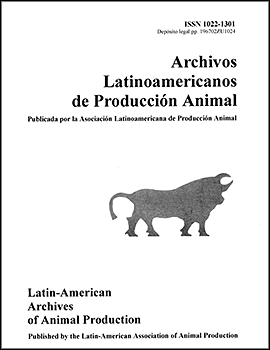
|
Archivos Latinoamericanos de Produccion Animal
Asociacion Latinoamericana de Produccion Animal
ISSN: 1022-1301
EISSN: 1022-1301
Vol. 17, No. 1-2, 2009, pp. 1-7
|
 Bioline Code: la09001
Bioline Code: la09001
Full paper language: Spanish
Document type: Research Article
Document available free of charge
|
|
|
Archivos Latinoamericanos de Produccion Animal, Vol. 17, No. 1-2, 2009, pp. 1-7
| es |
Variação percentual e freqüencia de alimento fornecido no desenvolvimento final de jundiás (Rhamdia quelen) na fase de recria
Graeff, Á. & Pruner, E.N.
Resumen
Foram utilizados 40 aquários de 40 L de capacidade, com abastecimento e escoamento individualizado, sendo que cada aquário foi considerado uma unidade experimental. O delineamento experimental foi inteiramente ao acaso em um esquema fatorial 5 x 2 onde o fator A foi o percentual de alimentação diária (1, 2, 3, 4, 5%) e o fator B foi a freqüência de oferta da alimentação (1 ou 2 vezes ao dia) com 4 repetições. As variáveis ganho de peso, comprimento, sobrevivência e conversão alimentar aparente foram submetidas à análise da variância. A ração utilizada foi comprada no comercio local com 28%PB e 2.800 Kcal de EM/kg de ração dentro dos critérios, para a espécie. Foram estocados 6 alevinos de jundiás (Rhamdia quelen) por aquário com peso médio de 0.08 ± 0.01g e comprimento médio de 1.5 ± 0.1cm, com 23 d de idade. As avaliações da temperatura da água foram feitas diariamente, sempre às 09:00 e 15:00 h. Neste momento, os peixes recebiam a ração diária. A biometria dos peixes foi realizada no inicio do experimento, com 30 d e no final do experimento com 65 d, utilizando-se 100% dos peixes estocados, quando foram realizadas as medidas de comprimento total, peso individual, sobrevivência e conversão alimentar aparente. Os resultados indicaram que no cultivo de alevinos de jundiás na fase de recria a freqüência de alimentação ideal é uma vez ao dia no percentual de 2% do seu peso por dia.
Palabras-clave
Alimentação porcentual, Freqüência, Jundiá, Recria, Rhamdia quelen
|
| |
| en |
Variation in daily percentage of liveweight and frequency of feeding during the development phase of silver catfish (Rhamdia quelen)
Graeff, Á. & Pruner, E.N.
Abstract
The experiment was conducted in 40 aquaria of 40-L capacity with individual water intake and drainage and each aquarium was considered an experimental unit. The experimental design was completely randomized in a 5 x 2 factorial arrangement, in which factor A was the daily feeding level as a percentage of liveweight (LW; 1, 2, 3, 4, and 5%) and factor B was the feeding frequency (1 or 2 times daily), with four repetitions per treatment. Data of the response variables gain in LW and in body length, survival rate and apparent feed conversion ratio were subjected to analysis of variance. The locally purchased commercial feed used had 28% crude protein and 2 800 kcal ME/kg, thus being within the limits of established specifications for the species. Each aquarium was stocked with six 23-d old fingerlings of silver catfish (Rhamdia quelen) with a mean initial LW of 0.08 ± 0.01 g and body length of 1.5 ± 0.1 cm. Water temperature was monitored daily at 09:00 and 15:00 h., at which time the fish were fed. At the start, after 30 d and at the end of the experiment (65 d) 100% of the stocked fish were used to determine individual LW, body length, survival and feed conversion. The results indicated that in the culture of silver catfish fingerlings in the development stage, once daily feeding at the rte of 2% of LW is recommendable.
Keywords
Feeding frequency, Feeding percentage, Growth, Rhamdia quelen, Silver catfish
|
| |
© Copyright 2008 Archivos Latinoamericanos de Produccion Animal.
Alternative site location: http://www.alpa.org.ve/ojs/index.php
|
|
